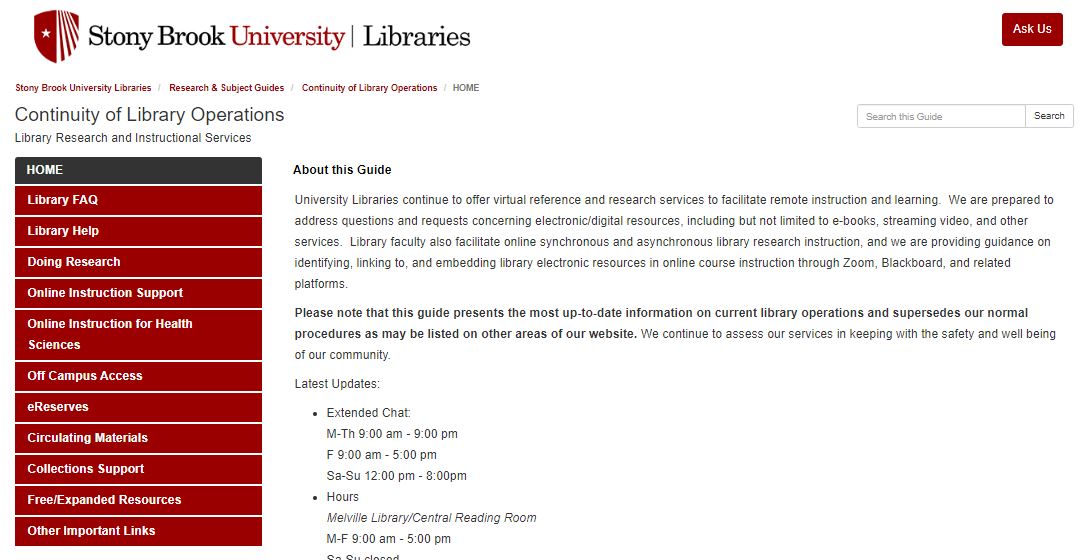A Timeline History of the University Libraries
This photograph taken in 1969 captures the beginning of the expansion project on the
Melville Library.
The construction took place between 1969 and 1971 - and amazingly, the library never
closed!
Source: University Archives, SBU Libraries.
EARLY HISTORY OF STONY BROOK UNIVERSITY
1948: New York State adopts the State University of New York system. This system links 31 state-supported campuses. Most are teacher-training schools, with a total of 28,300 students. Today, the SUNY system is comprised of 64 campuses.
William Robertson Coe presents his 400-acre Long Island estate, located in Oyster Bay and called Planting Fields, to New York State for use as a school of horticulture after his death.
1956: Ward Melville donates land in Stony Brook and his estate in Old Field known as “Sunwood” to the State University of New York. The acreage, valued at $4.5 million, will be the future location of the State University of New York at Stony Brook.
1957: The State University College of Long Island at Oyster Bay opens on September 16, 1957. Planting Fields in Oyster Bay (New York), given by the late William R. Coe to the State University of New York, was the site of the college until the permanent campus at Stony Brook was completed.
The 60-room mansion named Coe Hall provided space for classrooms, offices, dining hall and library. Other buildings provide dormitories, laboratories and faculty offices.
There are 144 first-year students and 14 faculty members.
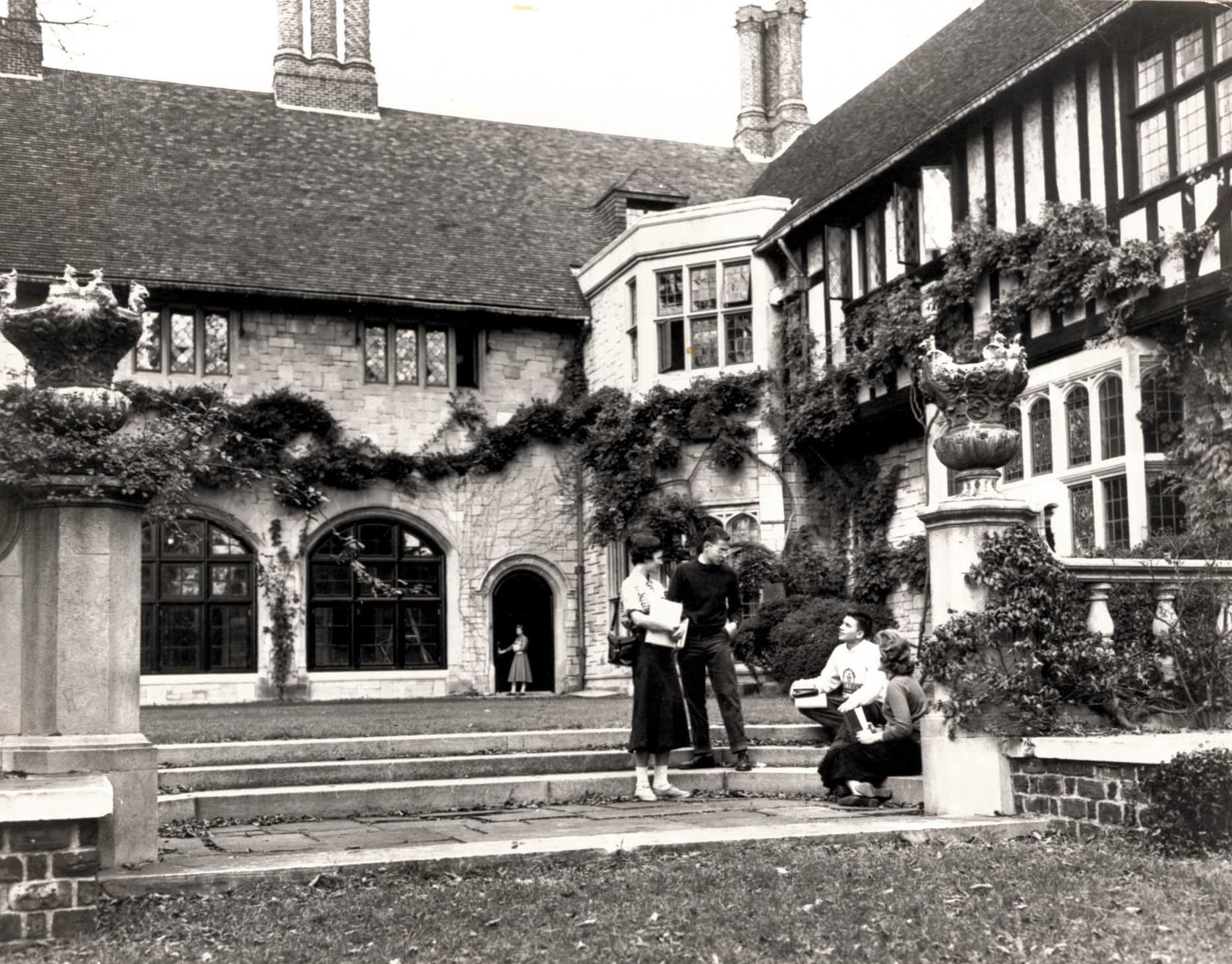
Students gathered outside Coe Hall at Planting Fields, Oyster Bay, NY, c1958.
Planting Fields was the temporary campus while the Stony Brook campus was under construction.
The college is tuition-free!
Source: University Archives, SBU Libraries.
1957: The first library space opens on the main floor and mezzanine of Coe Hall.

Leather-bound books, a chandelier, taxidermy, and a mezzanine were features
of the library in Coe Hall, Planting Fields, in Oyster Bay, c1958.
Source: University Archives, SBU Libraries.
1960: On April 8, the formal groundbreaking ceremony is held for the newly named State University of New York, Long Island Center at Stony Brook. Pictured are New York State Governor Nelson Rockefeller (left), benefactor Ward Melville (center), State University of New York Trustee Chairman, Frank Moore (right), and others.
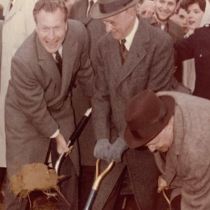
Groundbreaking on the Stony Brook Campus, April 8, 1960.
Source: University Archives, SBU Libraries.
1961: The first class graduates.

First graduating class posing on the west portico of Coe Hall at Planting Fields,
Oyster Bay, NY in 1961.
Source: University Archives, SBU Libraries.
THE MOVE TO STONY BROOK
1962: While some classes and laboratories continue at the Oyster Bay campus for a fifth and final year, the new Stony Brook campus opens. It is known as the State University of New York at Stony Brook (SUNY at Stony Brook).
There are two completed academic buildings: Humanities and Chemistry. Most classes are held in the Humanities building. It also has a single dormitory, G Dorm, which accommodates 616 resident students. G Dorm also houses the administrative, athletic, student government and newspaper offices, and the infirmary.
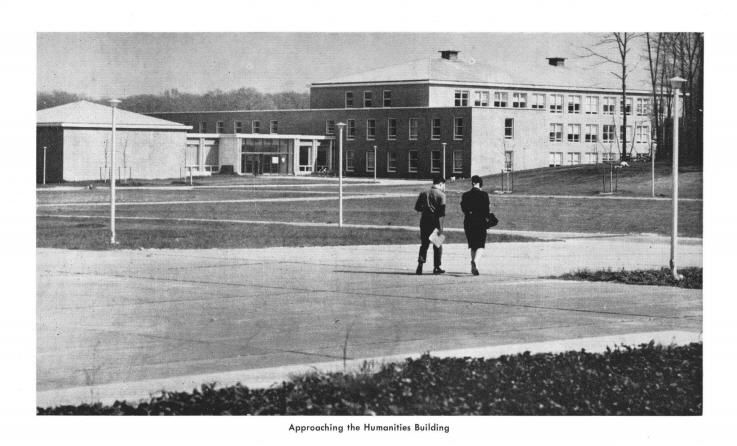
Humanities building, c1962.
Source: University Archives, SBU Libraries.
The library building was under construction; goals were have seating for 750 people and to house 350,000 volumes. It was equipped as an open-stack library, with carrels, study rooms, projection and music rooms. The number of subscriptions for periodicals in Physics, Chemistry, Engineering, and Mathematics was about 500 titles.
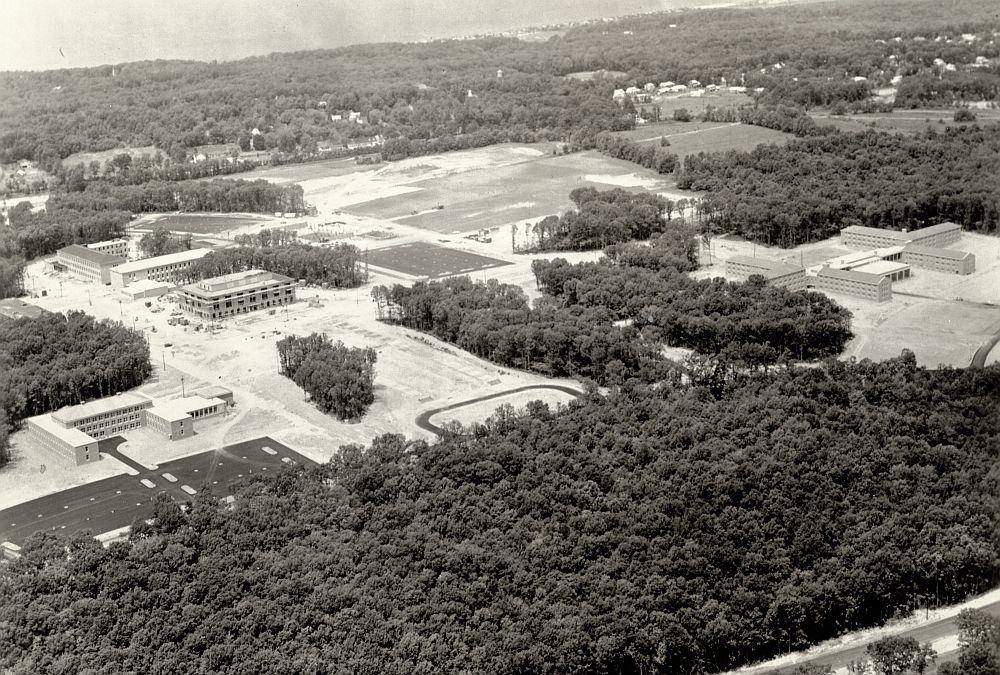
Aerial photograph of Stony Brook University, c1962. The Library is seen under construction,
center left.
Nicolls Road appears at the bottom and the Long Island Sound at the top.
Source: University Archives, SBU Libraries.
THE LIBRARY OPENS!
1963: The original library on the Stony Brook campus opened in July 1963 with seating for 700 students. The architectural firm of Damaz, Pokorny, and Weigel designed the modular library. In modular design, new sections can be created and function independently. The intent was to eventually increase the footprint of the building to keep pace with the university’s rapidly expanding programs and growing enrollment.
Roscoe Rouse is named Library Director.
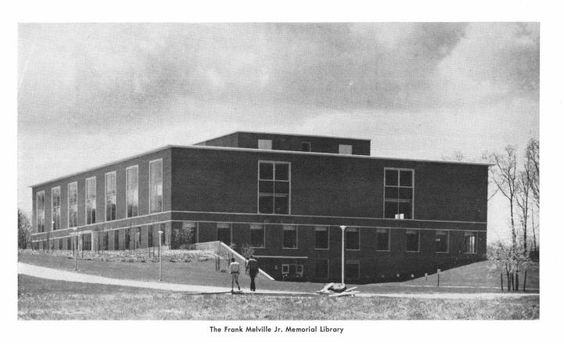
Postcard of the Frank Melville Jr. Memorial Library, c1965.
Source: University Archives, SBU Libraries.
1964: The library is referred to as the Frank Melville Jr. Memorial Library on October 14.
1965: The library was touted as an "air conditioned structure."
It had a print collection of 100,000 volumes and was a selective government depository and received large numbers of publications issued by the U.S. government. The library also had recordings of music as well as records of speeches, poetry, and drama.
About 2,000 periodicals were received covering all areas of knowledge, and the staff processed books at the rate of more than 20,000 per year.
There were plans for a music library to occupy a portion of the first floor. According to the 1965-1966 Undergraduate Bulletin, "The latest electronic equipment will be installed, including the use of tapes and cartridges operated by remote control under the direction of a music librarian and a skilled electronics engineer. The plan of the building is based on the module so that its function will be flexible and changes can be made in the interior plan when desired. This building is intended as the first part of a large structure that will ultimately store a million volumes and will serve a student body of ten thousand. Until the completion of an administration building, the Melville Library will house the administrative and business offices on one half of the second floor."
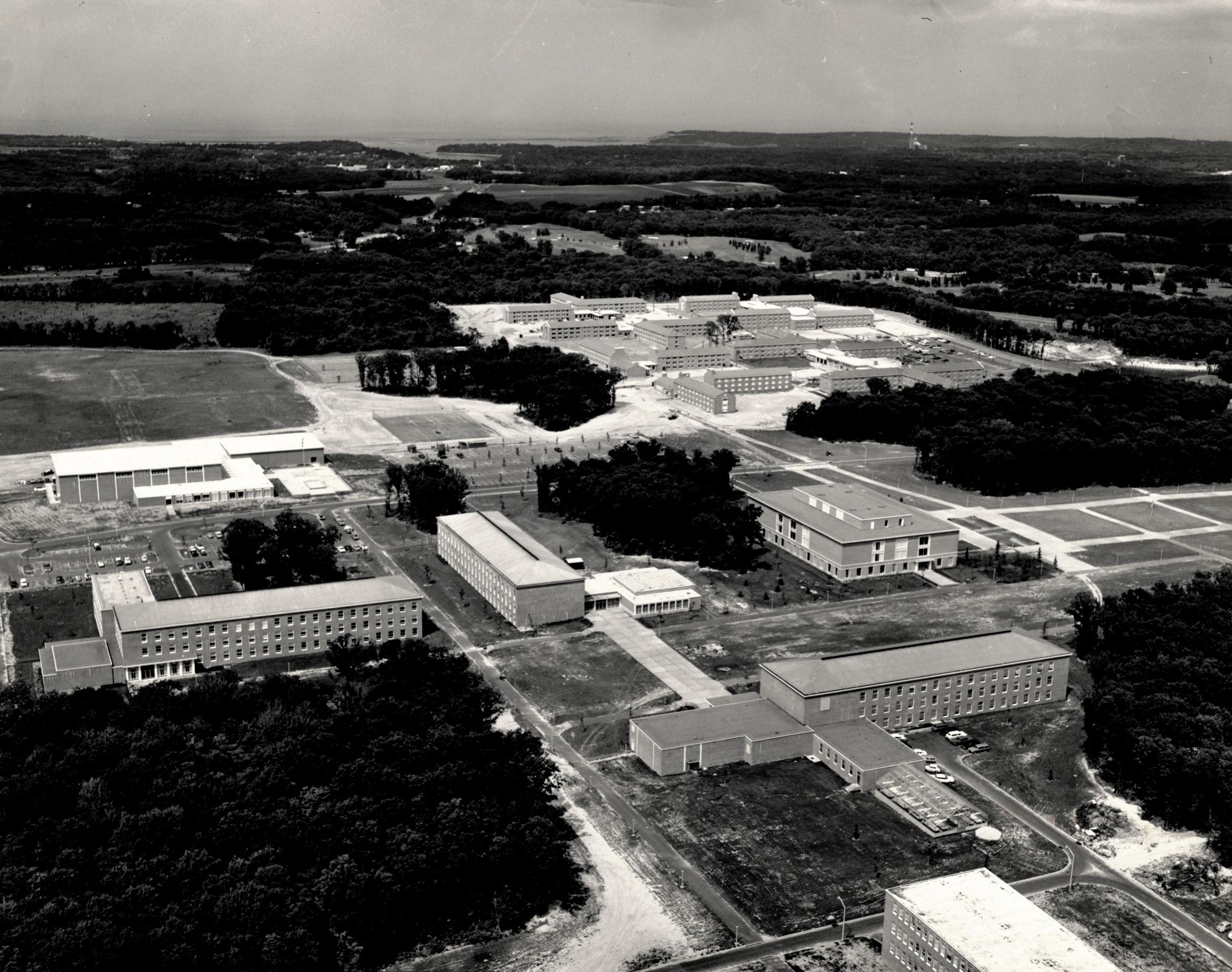
Aerial photograph of the Stony Brook campus, c1965. Can you locate the original Library?
(Hint: The present-day Frey Hall is located in the center of the photograph).
Source: University Archives, SBU Libraries.
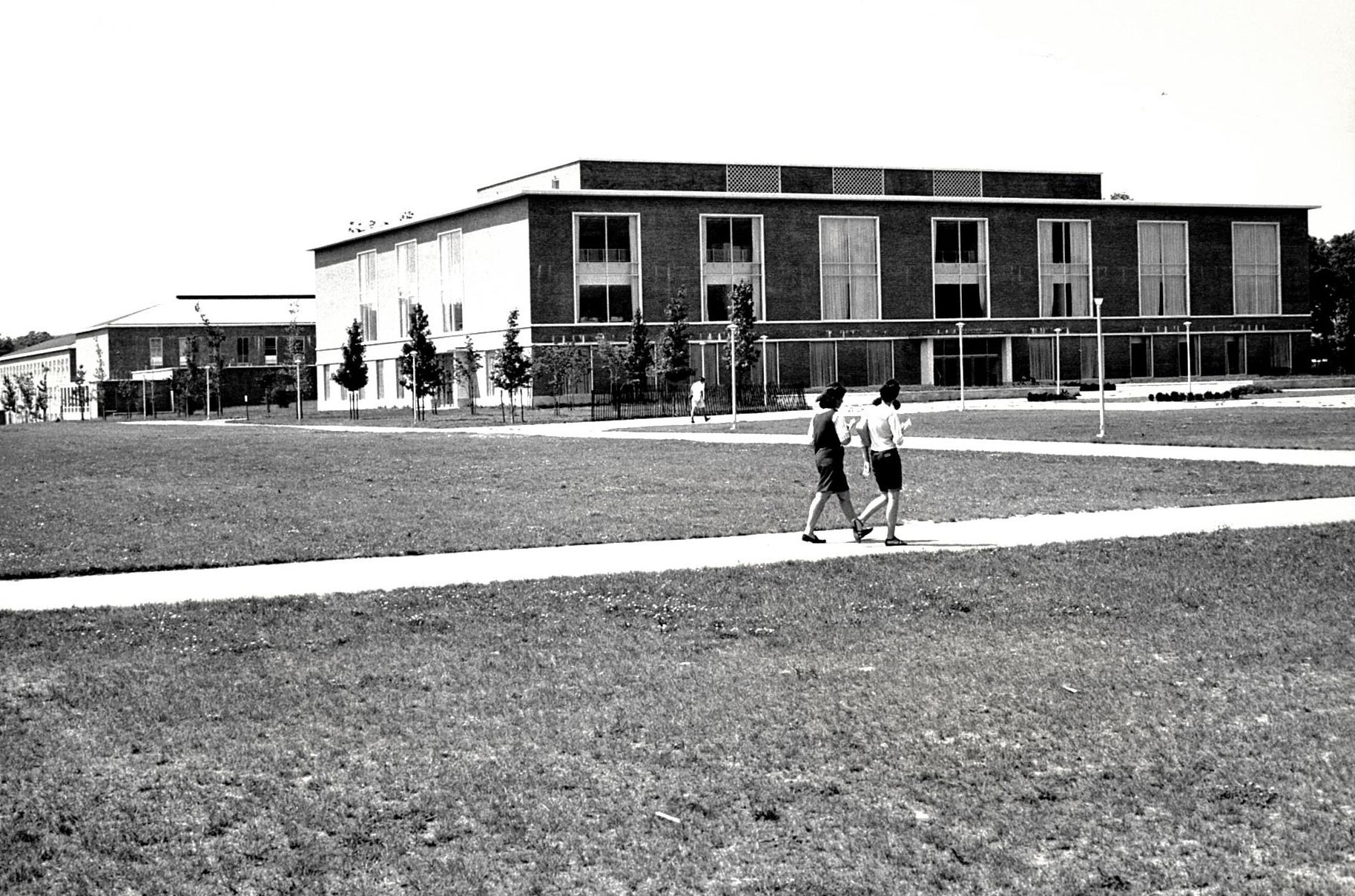
Walking along the east side of the Library, c1965.
The original Chemistry building (now Frey Hall) is pictured in the background.
Source: University Archives, SBU Libraries.
1966: Seminar rooms and soundproof "typing rooms" were available in the Melville Library. There was a special room for the housing and use of microform equipment, including reading machines for microfilm, microcards, microprint, and microfiche and a microprint reader-printer. A photocopy machine was available for the purpose of copying pages from magazines and reference books.
The collection now numbers 175,000 volumes and 48,000 documents.
THE BRIDGE TO NOWHERE
1967: Gruzen and Partners designed the large pedestrian bridge to connect Fine Arts, the
Student Union, and the Library, fondly known as the Bridge to Nowhere, because it
did not connect to the Fine Arts building for nearly 10 years after ground was broken.
The course bulletins state "a second unit of the library, which will increase its
capacity by two and one half times, is now in the planning stages. It is expected
to be occupied by 1970."
Ruben Weltsch replaces Roscoe Rouse as Library Director.

The Bridge to Nowhere, c1968. The original Library building is pictured on the far
left in the photograph.
Source: University Archives, SBU Libraries.
MELVILLE LIBRARY EXPANSION
1968: The university states the library constitutes the first phase of a larger structure that will house a million volumes at its next stage of development.
Four scientific collections are housed in the science and engineering buildings.
During regular semesters the Melville Library is open until midnight except on Saturday.
Small study rooms are provided in the Melville Library. A special area houses the files of microfilm, microcards, microprint, and microfiche.
A Xerox copier is available for student use.
Also in 1968: a "Biomedical Library" housed in the Blue Jay Market in Setauket (on 25A) was established to service to the community. It would open shortly after the arrival of the Director of the Biomedical Library, Emil Frey. It was stated: "The library will also function as a regional resource for the entire Nassau-Suffolk community. It should be able to serve physicians, other health professionals and hospital libraries with materials, consultation and eventually computer hook-up."
NEW MELVILLE LIBRARY DESIGN
1969: Architect Ervin Galantay transformed the existing library into one of the largest and most imposing buildings on campus.
Designed as an addition to the original library, it wraps around perimeter of the original library, which remained intact.
Construction involved building four, five-story wings around the original library structure. The plan was for the building to house a general studies undergraduate library on the first and second floors, a humanities section on the third, and a graduate library on the fourth and fifth floors, with individual cubicles for private study.
A glass atrium would connect the original building to the new areas of the building.
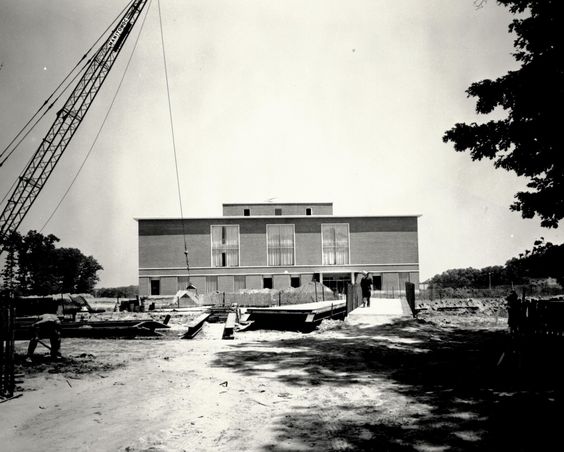
Start of construction to expand the Library building, 1969.
Source: University Archives, SBU Libraries.
Also in 1969: Emil Frey is recruited as director for the Health Sciences Center Library.
The Special Collections department is established.
1970: New books were added to the collection at the rate of 100,000 a year; in total there were about 500,000 volumes.
A million volume collection was anticipated by 1975 after completion of a library expansion program now underway.
There was also a microfilm library consisting of 20,000 reels and 600,000 flat sheets.
Specialized libraries were also maintained on campus. These include the chemistry, earth and space sciences, health sciences, physics-mathematics and engineering libraries.
1970: Emil F. Frey, Director of the Health Sciences Library announced in May 1970 that a separate Health Sciences Library was being developed. It would be operated independently as a unit in the Health Sciences Center.
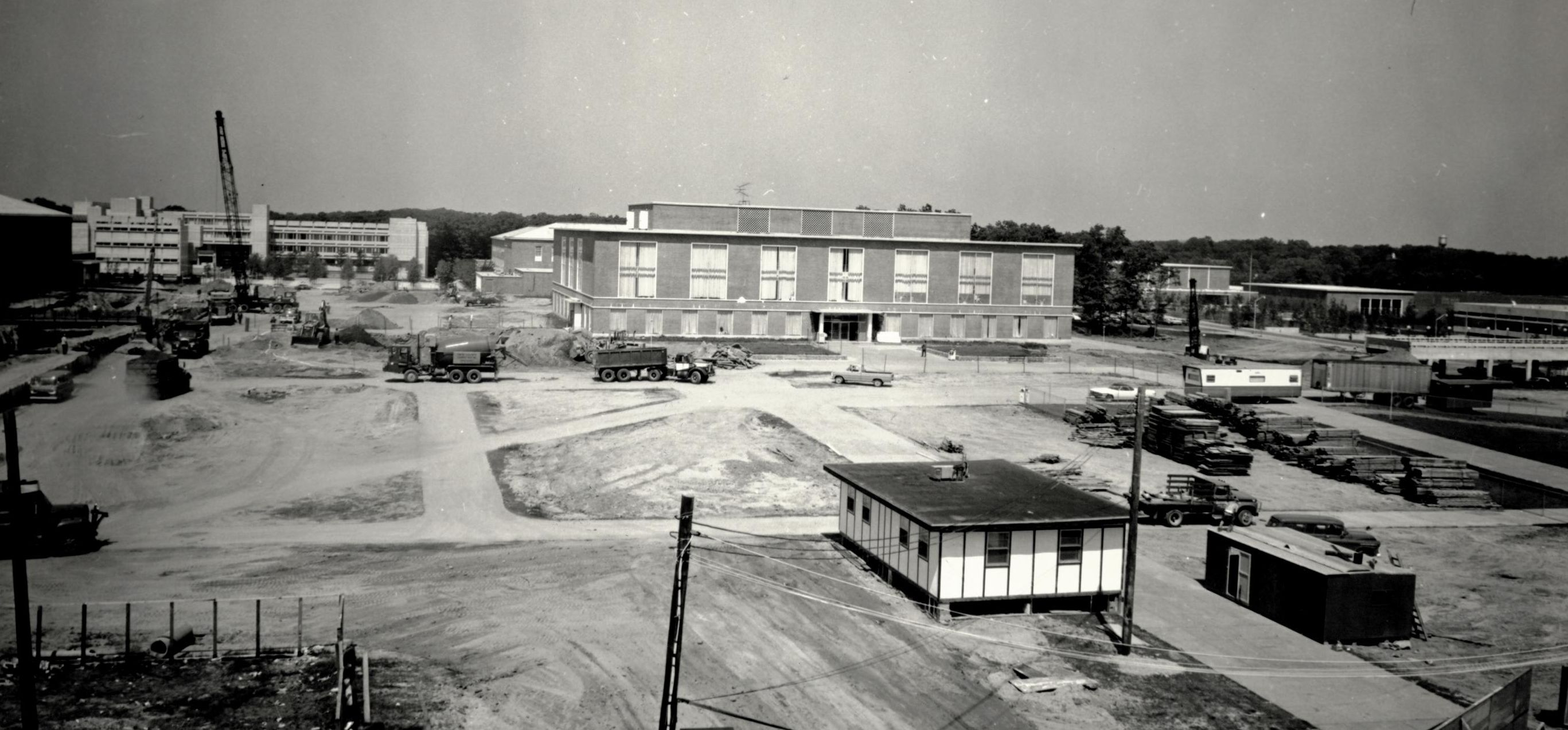
Melville Library, June 1970. The Earth and Spaces Sciences building is pictured on
the far left.
Source: University Archives, SBU Libraries.
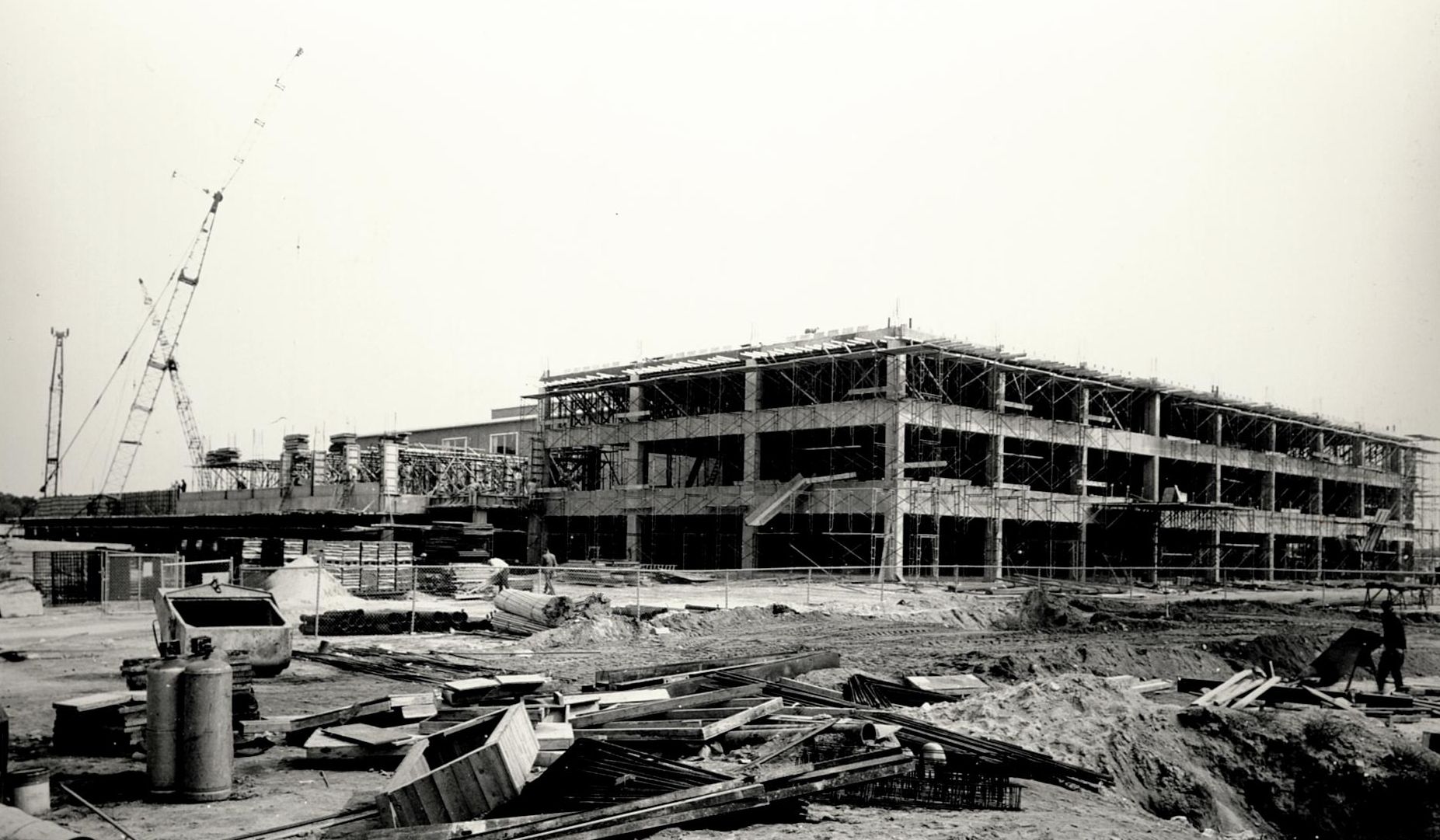
Melville Library, circa October 1970.
Source: University Archives, SBU Libraries.
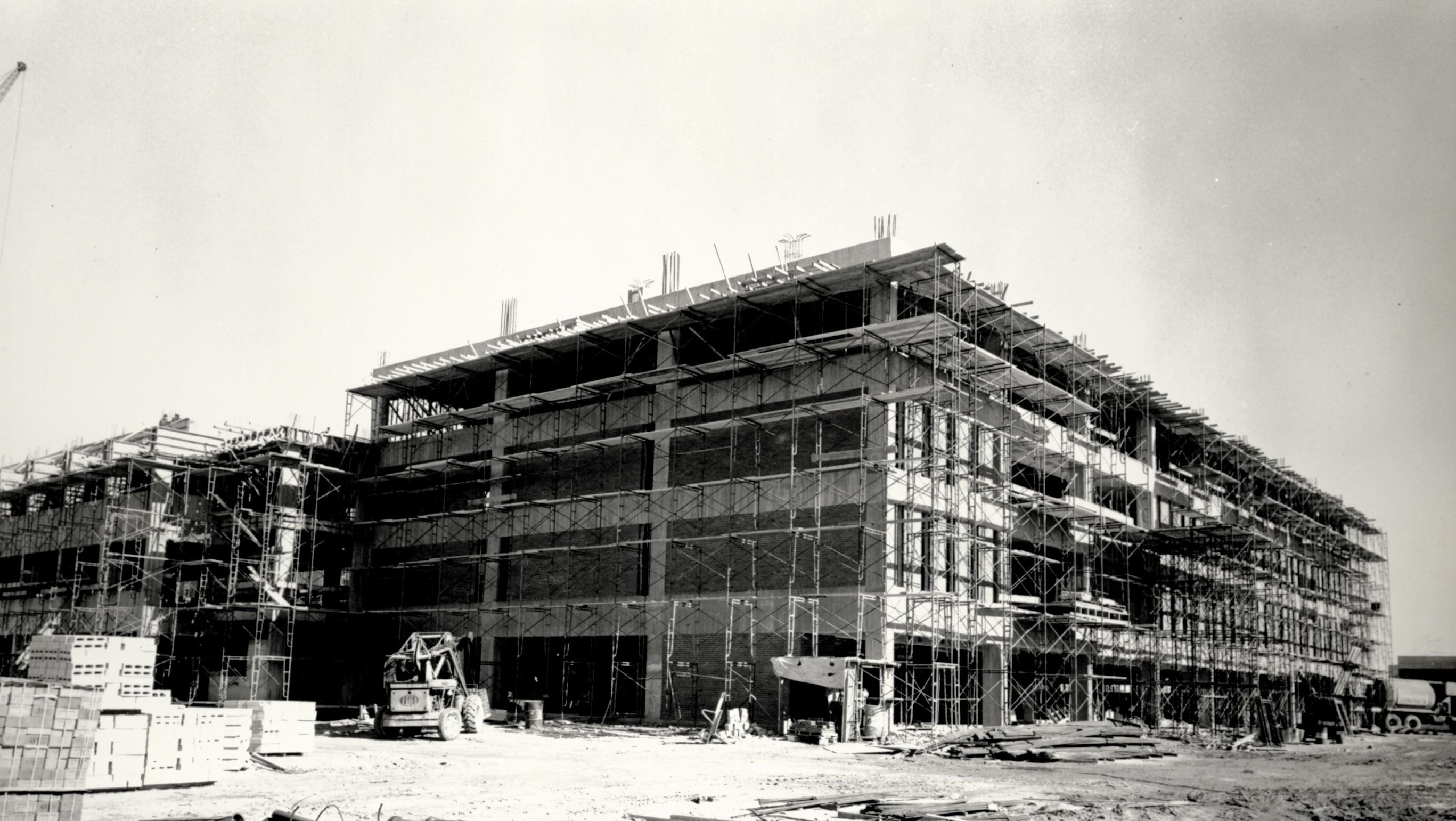
Melville Library, November 1970.
Source: University Archives, SBU Libraries.
1971: After a major expansion which nearly quadrupled the square-footage, the library reopens with signage “Frank Melville Jr. Memorial Library” installed on the exterior, in honor of Stony Brook philanthropist Ward Melville’s father.
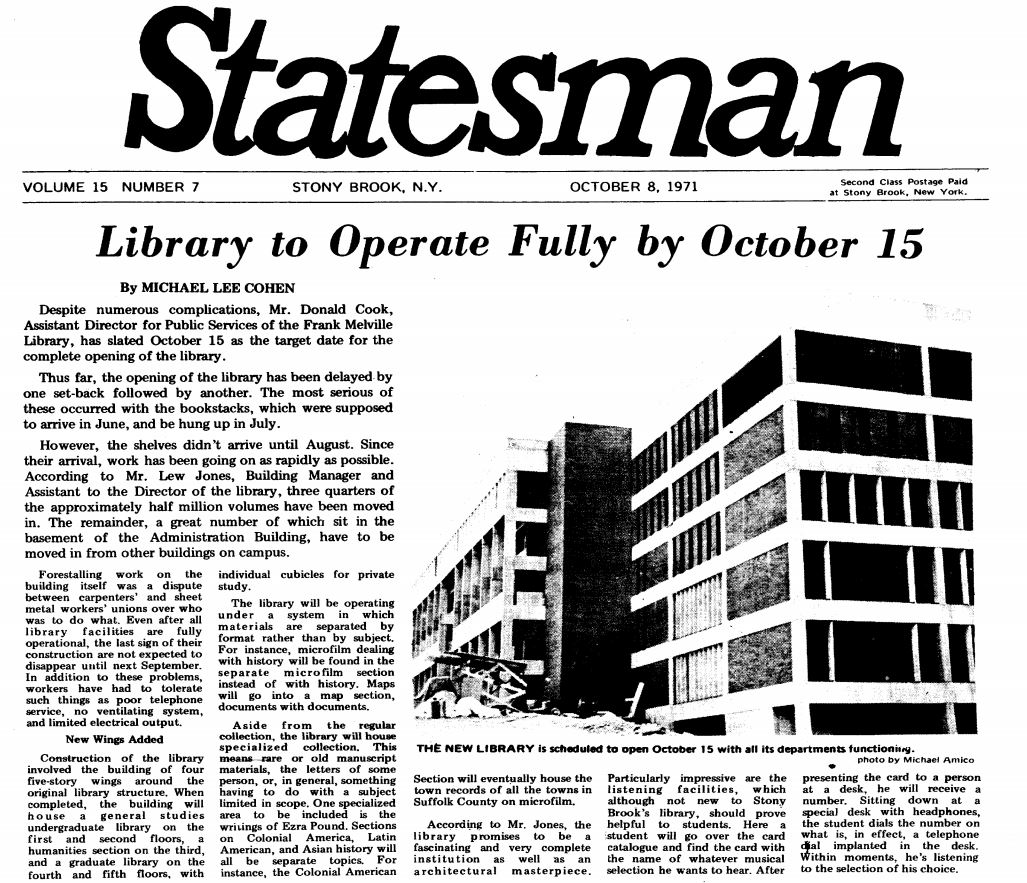
"Library to Operate Fully By October 15 [1971]."
Source: Statesman, October 8, 1971.
The first phase of the new building, located in the heart of the campus, was completed in the fall of 1971, while final occupancy of the entire "Library-Humanities Building" was scheduled for fall, 1972.
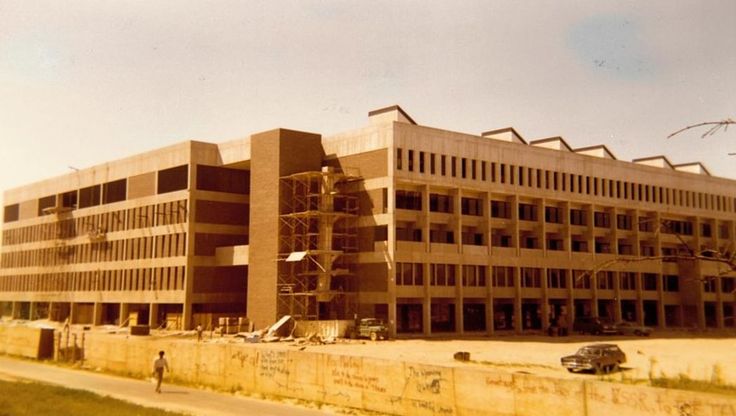
Melville Library, c1971.
Source: University Archives, SBU Libraries.
New volumes were added to the collection at the rate of 100,000 volumes a year; in total there were 600,000 volumes.
The libraries received approximately 6200 periodical subscriptions.
Among specialized departments within the main library building were: microforms, consisting of 24,000 reels and 750,000 flat units; the Music Library and listening facility; the United States, United Nations and New York State Documents Section; the Environmental Information Service; and the Department of Special Collections.
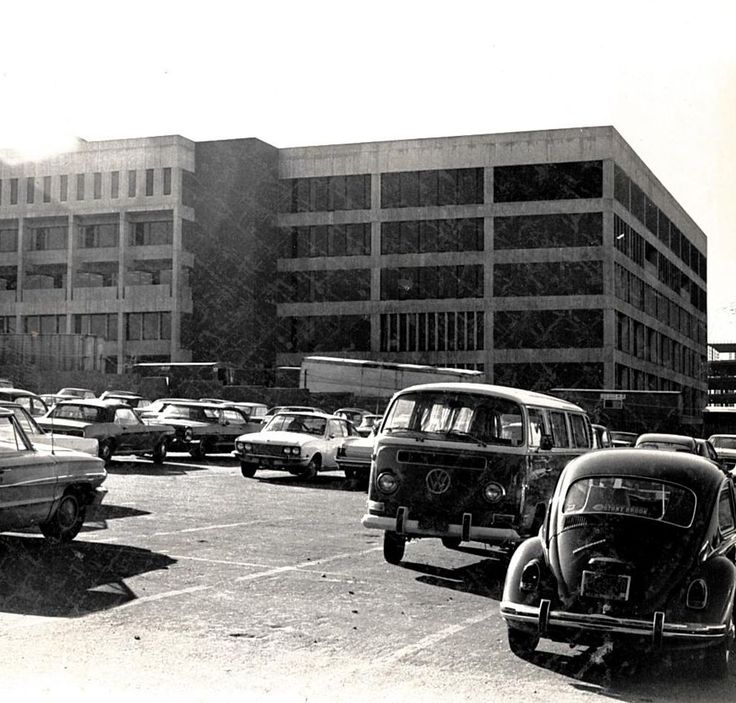
Before the days of parking permits and the Staller steps: cars parked outside of the
Melville Library, c1971.
Source: University Archives, SBU Libraries.
Separate chemistry, earth and space sciences, mathematics, physics, and engineering departmental libraries, located in their respective academic buildings, were under the jurisdiction of the main library.
1972: Joseph Gantner takes over as Acting Library Director.
1974: John Brewster Smith named Dean and Director of Libraries.
The 1974-1975 Undergradute Bulletin states, "The Frank Melville, Jr. Memorial Library, at the heart of the campus, and its six departmental branch libraries have a total of 785,000 volumes, 800,000 items in microformat and subscriptions to 6200 periodicals."
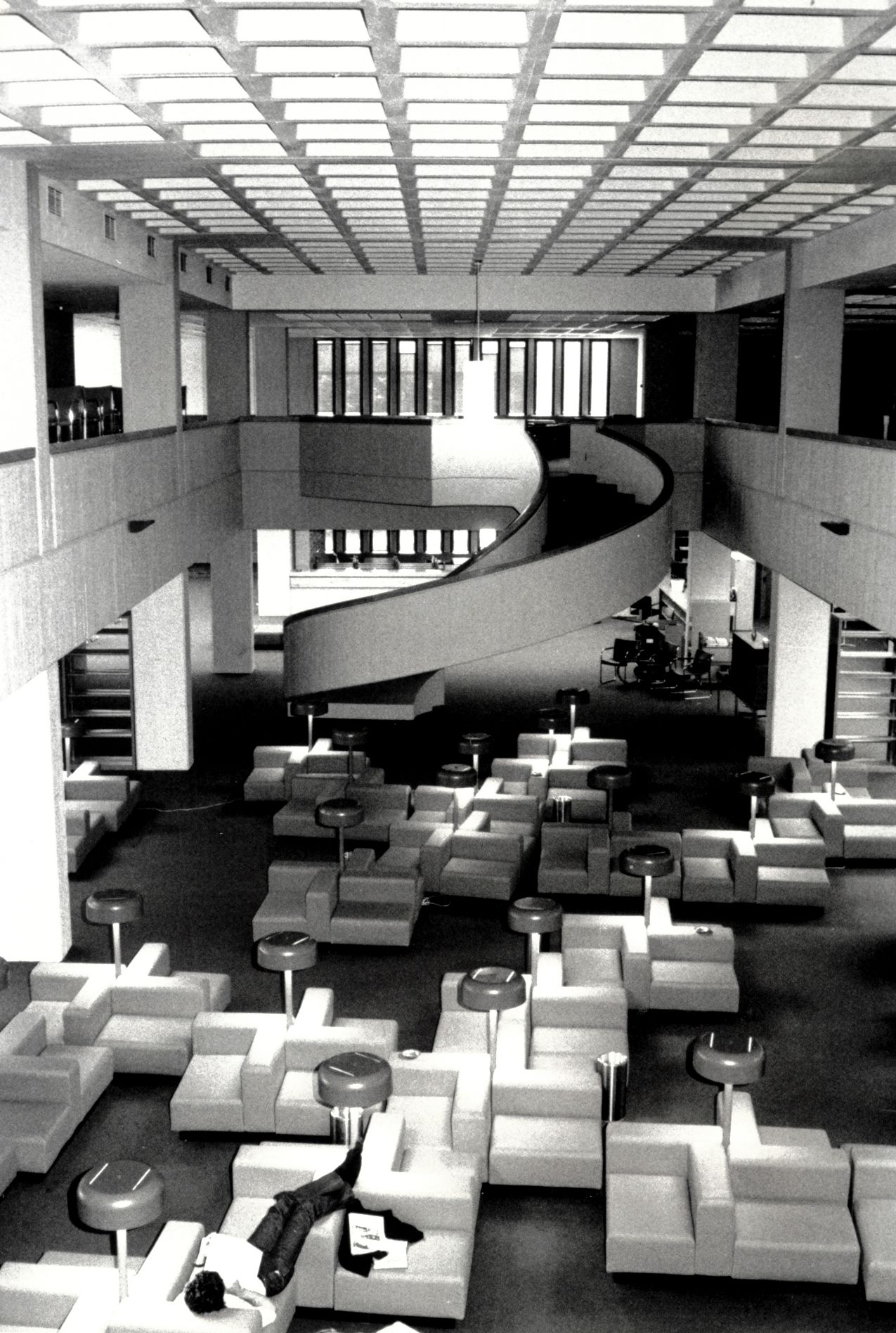
Area of the present-day North Reading Room, c1975.
Source: University Archives, SBU Libraries.
1976: The 1976-1977 Undergradute Bulletin states, "The Frank Melville, Jr. Memorial Library provides both an intellectual and physical focal point for the campus. The combined collections of the Melville Library, its five departmental branch libraries and the University's Health Science Library this year reached 1,000,000 volumes. In addition, library collections include 1,200,000 items in microformat and subscriptions to 9,187 periodicals."
1977: The “Bridge to Nowhere” is completed and dedicated. It measured 30 feet wide and 475 feet long, but rather than connecting to the Melville Library, it provided direct access to the Fine Arts building.
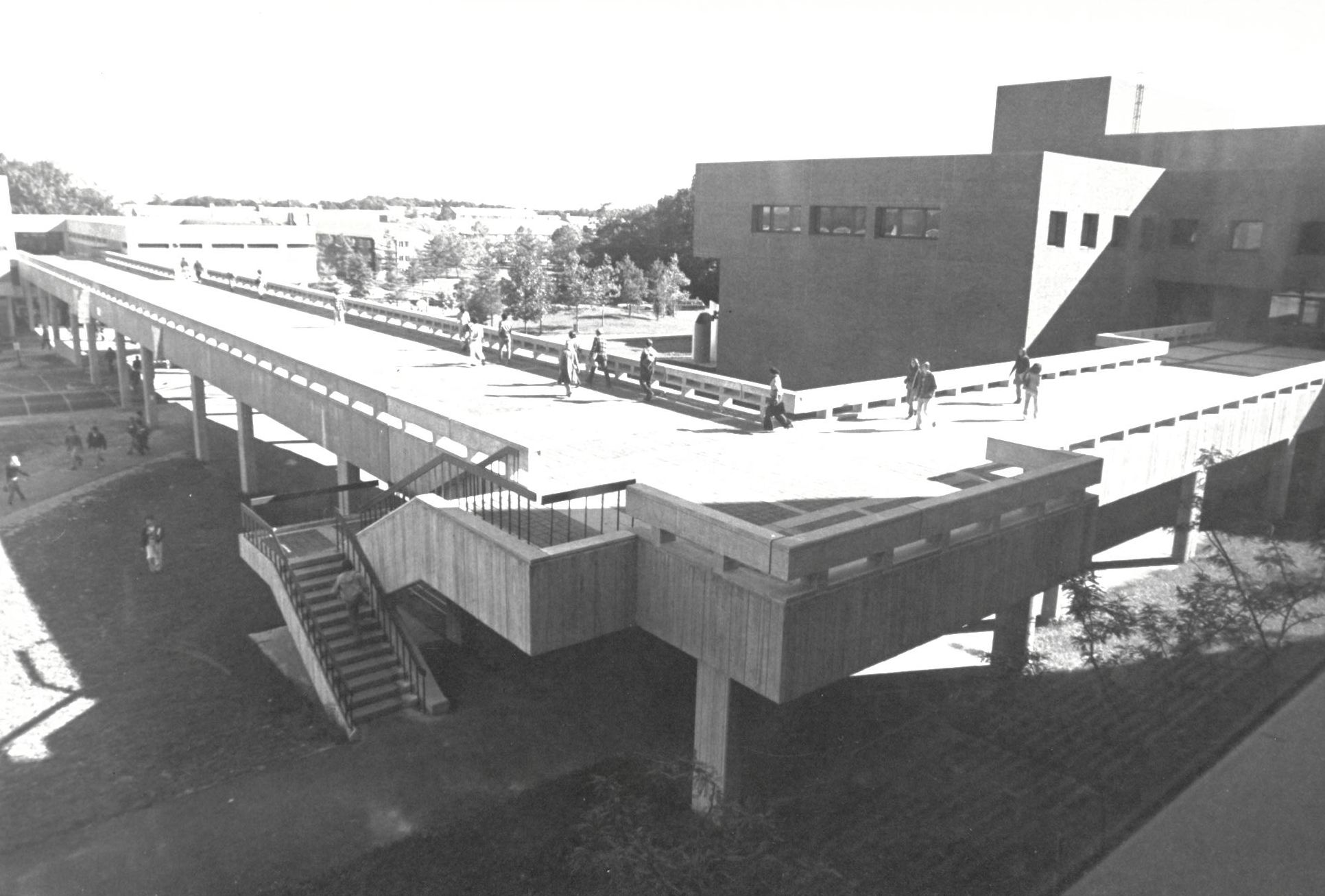
Bridge to Nowhere, c1980.
Source: University Archives, SBU Libraries.
1978: The Health Sciences Library had 135,000 volumes, 30,000 of which were books. The number of subscriptions was 3,600.
1981: Collectively, the University Libraries housed over 1,250,000 bound volumes and 1,600,000 publications in microformat.
Former United States Senator Jacob K. Javits donated his papers, covering his 34 years of public life, to the Special Collections department in the Frank Melville Jr. Memorial Library. Learn more about this collection here.
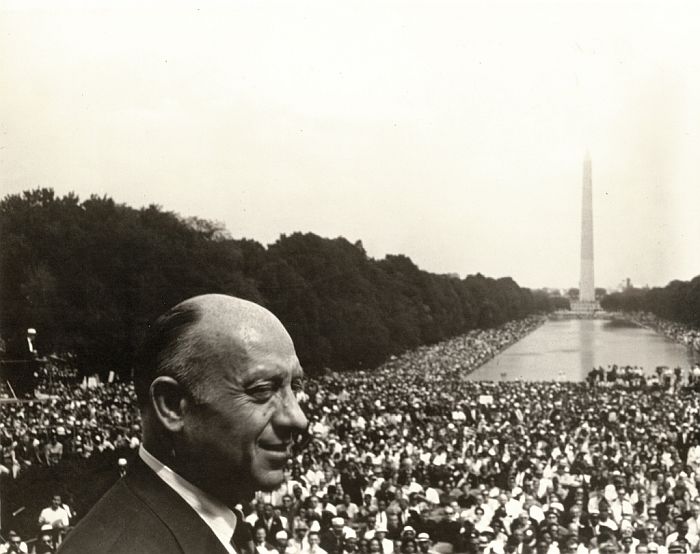
Special Collections received the papers of U.S. Senator Jacob K. Javits in 1981.
Photograph of Senator Javits at the "March on Washington," August 28, 1963.
Source: Senator Jacob K. Javits Collection, Special Collections, SBU Libraries.
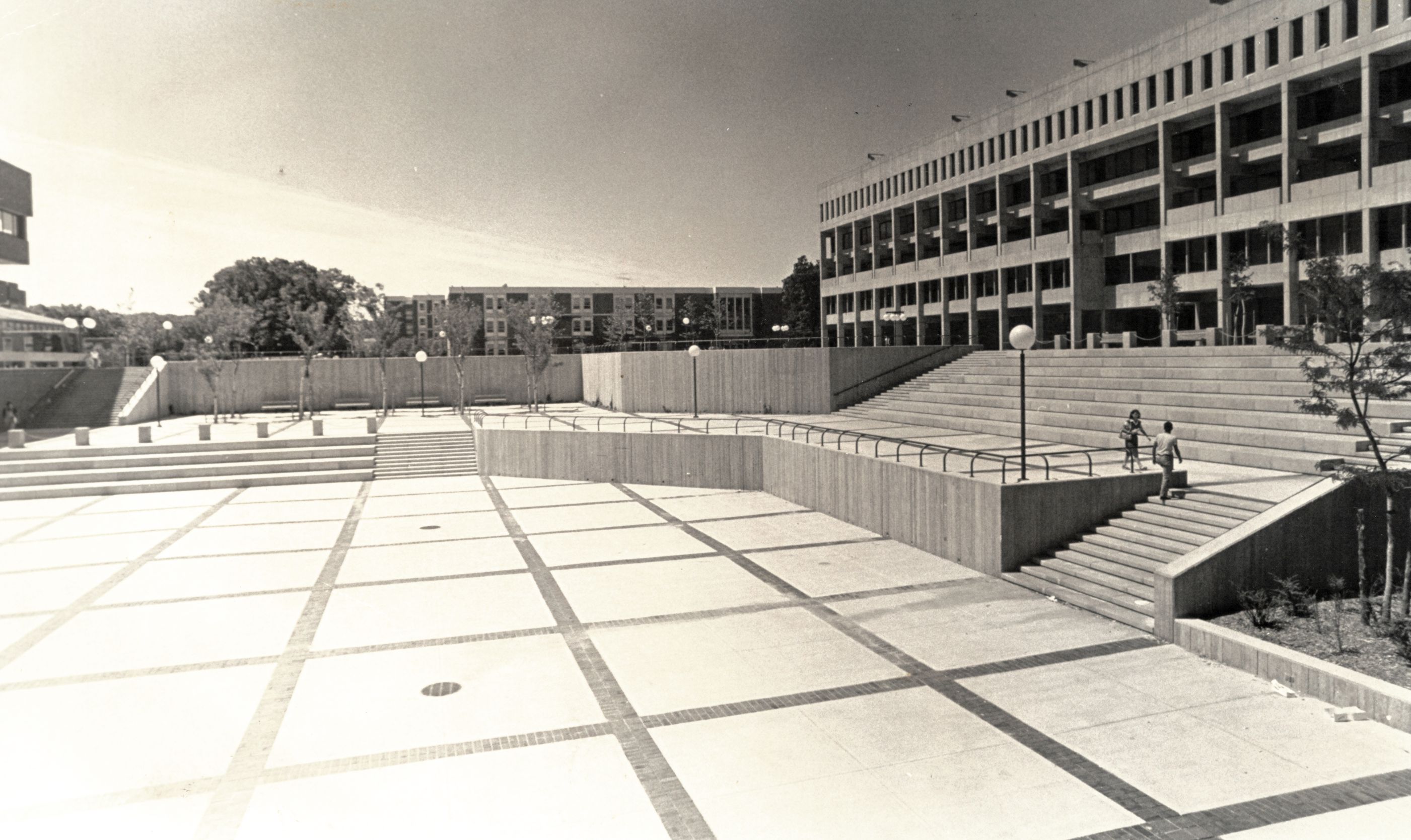
East side of the Melville Library, c1987. Yes, this is now the area of the grassy
Staller Center steps and Fine Arts.
Source: University Archives, SBU Libraries.
THE LIBRARY GOES "ONLINE"
1988: The library embarks on a major project to barcode its book collections. This work is done in preparation of launching the first database-driven catalog.
A contest was announced to name the online catalog.

Advertisement for the Library's "Name the Catalog Contest." The winner received $100.
Source: Statesman, August 28, 1988.
1989: The winning submission was STARS (STony Brook Automated Retrieval System) which remained the name of the catalog through September 2019. The name was submitted by Denise Clavin, a computer operator with the Information Systems Department at the University Hospital.
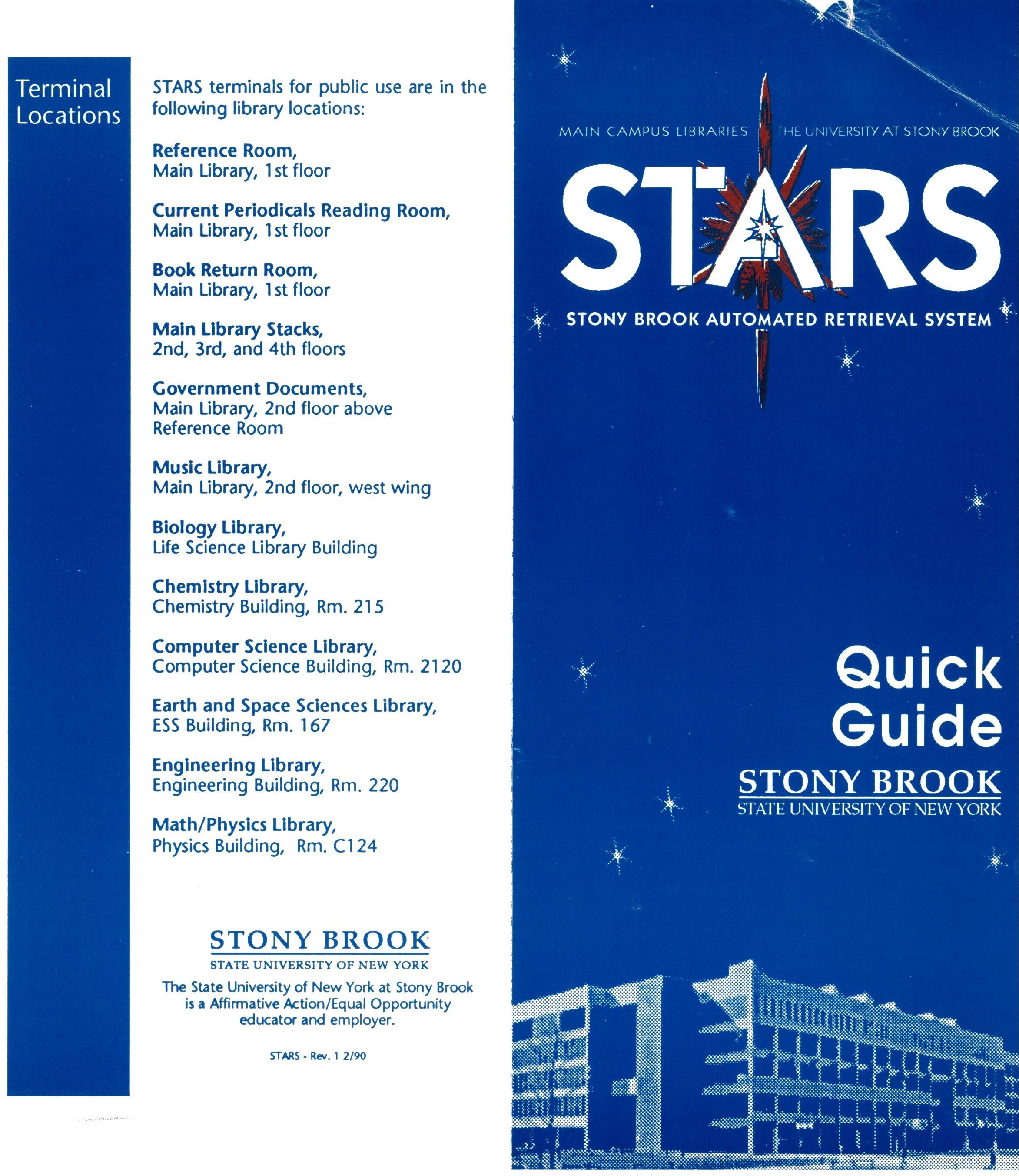
And the winner is...STARS! This brochure described how to use STARS and the location
of terminals to access it.
Brochure, c1990. Source: University Archives, SBU Libraries.
April 1994: A portrait painting of Stony Brook's third president, John H. Marburger III, is unveiled and permanently displayed in Melville Library.
August 1996: Joseph K. Branin named Dean and Director of Libraries. Under his leadership, many branch library collections were consolidated and relocated to the Melville Library.
Spencer Marsh is named the Director of the Health Sciences Library, a position he held until 2008.
June 1997: The University Libraries launches it first website.

First library website, June 1997. Source: Wayback Machine - Internet Archive.
October 1997: The Barry S. Coller Learning Center was dedicated on October 30, 1997 at the Health Sciences Library. Named in honor of Dr. Coller, a former faculty member in the Department of Pharmacology, the lab featured new classrooms and computer workstations.
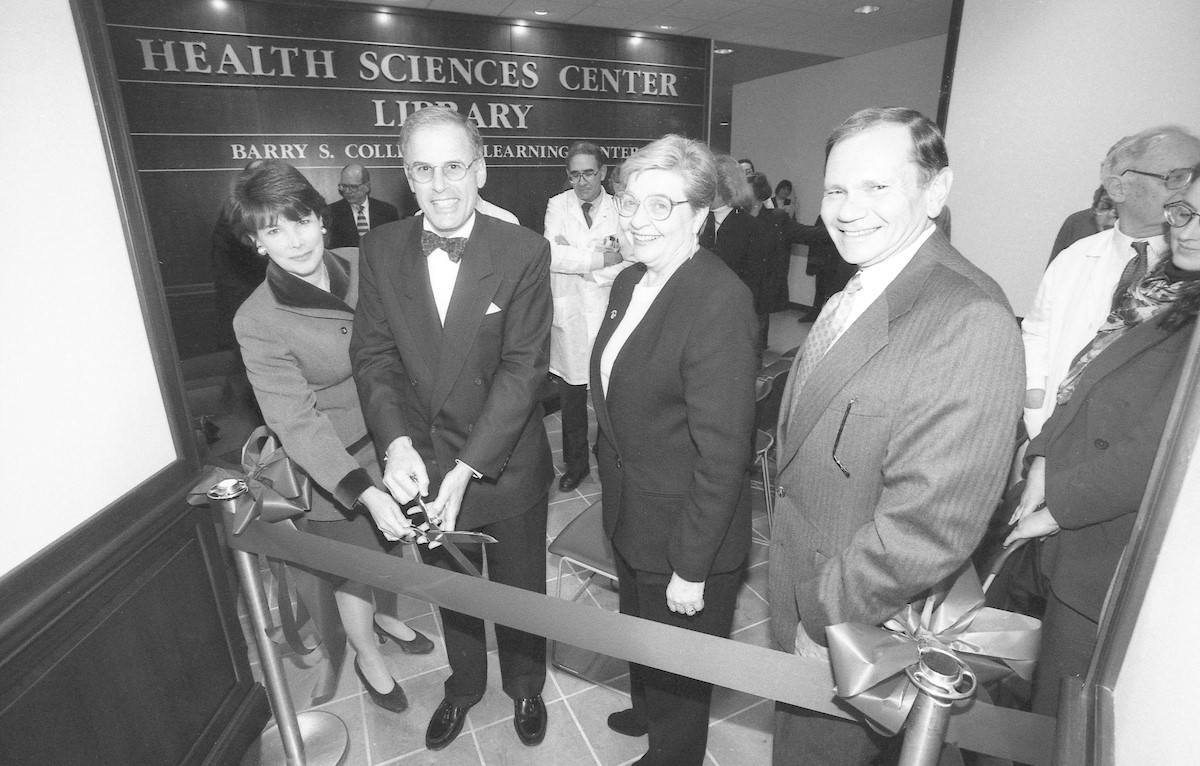
Dedication of the Barry S. Coller Learning Center on October 30, 1997.
Dr. Coller is pictured cutting the ribbon alongside University President Shirley Strum
Kenny and Dr. Norman H. Edelman.
Source: Stony Brook University.
December 1999: Charles W. Simpson named Interim Dean and Director of Libraries.
August 2000: E. Christian Filstrup named Dean and Director of Libraries.
April 2002: A steel sculpture designed by famed graphic designer Milton Glaser (1929-2020) is installed outside of the Frank Melville, Jr. Memorial Library, facing the academic mall.

Sculpture designed by graphic artist Milton Glaser (1929-2020).
Source: Stony Brook University.
May 2002: The legendary “Bridge to Nowhere” is demolished.
May 2006: Special Collections acquires an original letter authored by George Washington about the Setauket-based Culper Spy Ring.

A landmark acquisition: Letter from General George Washington the Major Benjamin Tallmadge,
dated September 24, 1779.
Source: Special Collections, SBU Libraries.
October 2009: The Library at Stony Brook Southampton opens; it is the first LEED-Certified library on Long Island.

Library at Stony Brook's Southampton Campus.
Source: Stony Brook University.
December 2010: Andrew White named Interim Dean and Director of Libraries.
January 2013: Daniel Kinney named Interim Dean and Director of Libraries.
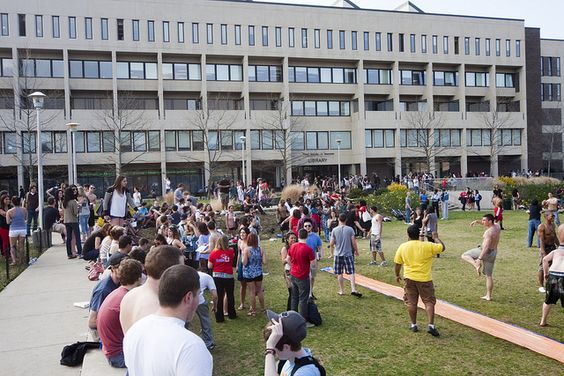
The Staller Steps outside the Melville Library is a favorite gathering spot on campus.
Photograph, c2013. Source: Stony Brook University.
September 2013: Constantia Constantinou named Dean of University Libraries.
September 2015: President Stanley announced a new plan to renovate and update reading rooms in the Frank Melville Jr. Memorial Library.
January 2016: Construction begins on North Reading Room renovation.
May 2016: The North Reading Room opens. The Central Reading Room closes for renovation.
September 2016: The Central Reading Room re-opens. The “Stony Brook Foundation Knowledge Commons” sign is installed in the North Reading Room and a ribbon cutting ceremony is held.

North Reading Room - Stony Brook Foundation Knowledge Commons in 2017.
Source: Stony Brook University.
August 2018: Shafeek Fazal named Interim Dean of Libraries.
September 2019: The University Libraries debut its new discovery catalog named "SEARCH." This new system is part of a SUNY-wide initiative to provide researchers the ability to search collections across all SUNY campuses from a single portal.
 Screenshot of the SEARCH discovery catalog, November 2019.
Screenshot of the SEARCH discovery catalog, November 2019.
https://library.stonybrook.edu/
Source: Stony Brook University Libraries.
March 2020: The University Libraries respond to the COVID-19 pandemic and provide continuity of library operations to facilitate and support remote access to library collections, learning, and instruction.
September 2022: Karim Boughida is Dean of Stony Brook University Libraries.
December 2023: The University Libraries celebrate the 60th Anniversary of the Meville Library.
SBU Libraries announces that it is a HathiTrust member library, part of a group of 200 plus libraries and institutions that comprise the HathiTrust community, providing access to more than 18 million digital items. It is finishing a five-year strategic plan that sets the course for achieving its vision, mission, and objectives – and continuing a legacy of innovation by leading new efforts in AI (artificial intelligence) and other cutting-edge, emerging technologies.
----------------------------------------------------------------------------------------------------------------------------------------
Timeline History and Website by Kristen J. Nyitray, November 2019. Last update: December 2023.
Emeriti Librarians
Albertson, Asano
Allen, David Y.
Andersen, Dennis
Baum, Nathan
Bolotine, David
Brand, Barbara
Constantinou, Constantia
Coven, Brenda
Feinberg, Richie
Filstrup, E. Christian
Galbraith, Jeanne
Hoffman, Elaine
Howard, Brigitte
Jo, Julitta
Johnson, Godlind
Kelly, Roger
Kenefick, Colleen
Kinney, Daniel
Lu, Min-Huei
Lobou, Robert
Marcolina, Ruth
Pandit, Jyoti
Robinson, Hannah
Tweedy, Doris
Volat, Helene
Volkersz, Evert
Walcott, Rosalind
Wiener, Paul
Williams, Doris
Yun, Jai
Deans & Directors of University Libraries
- July 1963 - July 1967: Roscoe Rouse (director)
- July 1, 1967 - July 1, 1972: Ruben Weltsch (director)
- July 1972 - February 1974: Joseph Gantner (acting director)
- March 1, 1974 - July 16, 1997: John Brewster Smith (dean and director)
- August 1, 1996 - December 18, 1999: Joseph J. Branin (dean and director)
- December 20, 1999 - August 1, 2000: Charles W. Simpson (interim dean and director)
- August 1, 2000 - November 1, 2010: E. Christian Filstrup (dean and director)
- December 2010 - January 27, 2013: Andrew White (interim dean and director)
- January 28, 2013 - October 1, 2013: Daniel Kinney (interim dean and director)
- October 1, 2013 - July 31, 2018: Constantia Constantinou (dean)
- August 1, 2018 - September 14, 2022: Shafeek Fazal (interim dean)
- September 15, 2022 - Karim Boughida (dean)
East Campus (Health Sciences Library)
-
1969 - 1973: Emil F. Frey (director)
-
1973: Mary Winkels (acting director)
-
1973 - 1979: Mary Winkels (director)
-
1979 - 1994: Ruth Marcolina (director)
-
1994 - 2008: Spencer Marsh (director)
- 2008 - 2009: Moisés Eisenberg (interim director)
-
2009: Andrew White (director)
*Note: after 2009, the West Campus and East Campus libraries merged as the University Libraries.*
About the University Libraries
Stony Brook University Libraries stand as the largest academic research library on Long Island, serving as a resource in the local community, state-wide, and nationally and internationally. It has six distinct facilities: Frank Melville Jr. Memorial Library, Marine and Atmospheric Sciences, Chemistry, Math/Physics, Southampton, Health Sciences Libraries, and SUNY Korea-SBU campus.
The Frank Melville Jr. Memorial Library is the main library building at Stony Brook University. Located on in the center of the academic mall on the west campus, it is named for the father of Stony Brook philanthropist Ward Melville.
The University Libraries is known for a wide-range of print and digital resources and world renowned Special Collections. It belongs to the Association of Research Libraries (ARL), with a Health Sciences Center Library that is a member of the Association of Academic Health Sciences Libraries.
The collections exceed 2 million volumes, including e-books, print and electronic holdings of scholarly subscriptions, microforms, music recordings, and maps.
The Libraries maintain memberships and affiliations in arXiv, Association of Research Libraries, SPARC, Center for Research Libraries, SUNY Connect, DuraSpace (as a SUNY Member) the council on Library and Information Resources, Digital Library Federation, Coalition of Networked Information, EDUCAUSE, Inter-University Consortium for Political and Social Research, Roper Center, OCLC Research Library Partnership, and ORCID through the National Network of the National Libraries of Medicine.

